Day 1 of a three day long weekend of tours today. It was forecast to be wet and windy today. It was certainly windy, but thankfully we saw next to no rain until we had finished for the day and were on our way back. We spent the day today down in the Norfolk Broads.
Our first stop was at Barton Broad. It wasn’t too windy as we walked down along the road to the boardwalk, although the debris from yesterday was scattered on the road, leaves and small branches. It was quite sheltered on the boardwalk and when we got to the platform at the end, the first thing we saw was a pair of Great Crested Grebes displaying just in front.
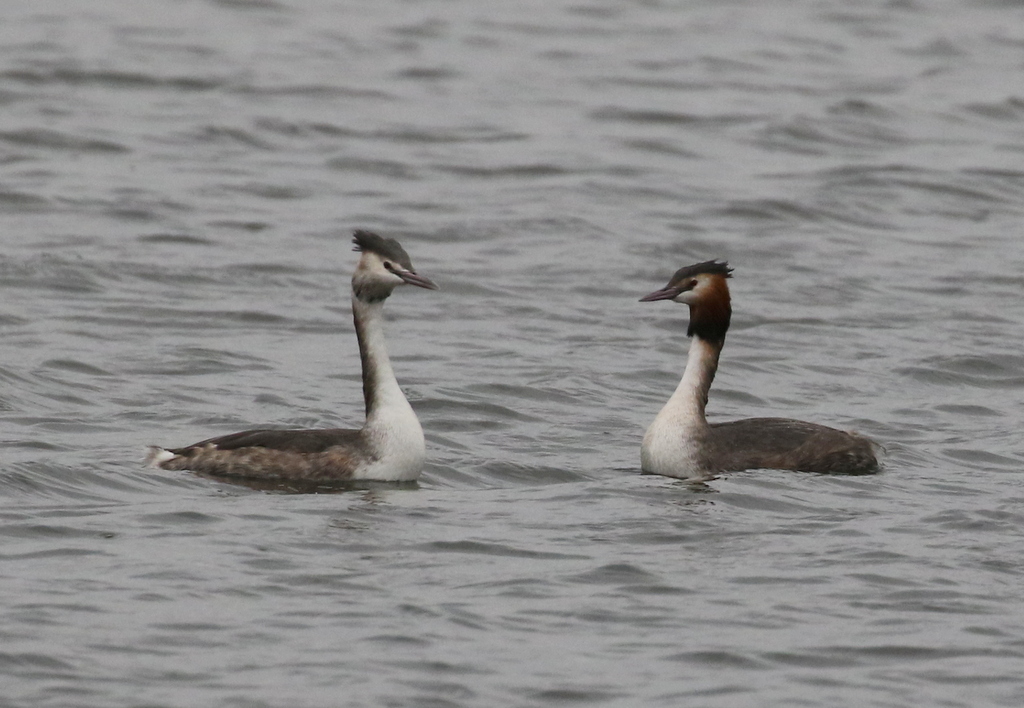
The Great Crested Grebes were facing each other, turning their heads alternately side to side. They didn’t get much beyond that though, swimming off separately before coming back and doing some more head turning.
Beyond the grebes, we could see quite a few ducks out on the Broad. In particular, there was a good number of Goldeneye on here again. Further back, a large raft of diving ducks were mostly Tufted Ducks, although a single drake Common Pochard was with them. We had really come to see the two female Scaup, and it didn’t take too long to find them, the thick white surround to their bills being particularly striking.
A Marsh Harrier flew down the far side of the Broad, above the trees, then cut across over the water in front of us and hung in the air over the near side. With our mission accomplished we set off back along the boardwalk. There were more tits in the alders here now, with both Great Tit and Coal Tit singing and a small flock of Long-tailed Tits once we were almost back to the road.
As we walked back towards the car park, a flock of small birds came out of the hedge and circled round over the field beyond. As they dropped down again into the stubble, against the background of the trees, we could see they were Yellowhammers. The wind was starting to pick up now and a few Redwings had been feeding in the shelter of the car park, under the cars, and flew off as we returned.
The plan was to head for Ludham next, to see if we could find some Bewick’s and Whooper Swans. As we were driving along the main road just past Horning, we spotted a large group of swans in a harvested sugar beet field. This was well beyond the normal range where we have seen the Ludham herd, so we assumed these would most likely be just Mute Swans until we pulled up and noticed they were not.
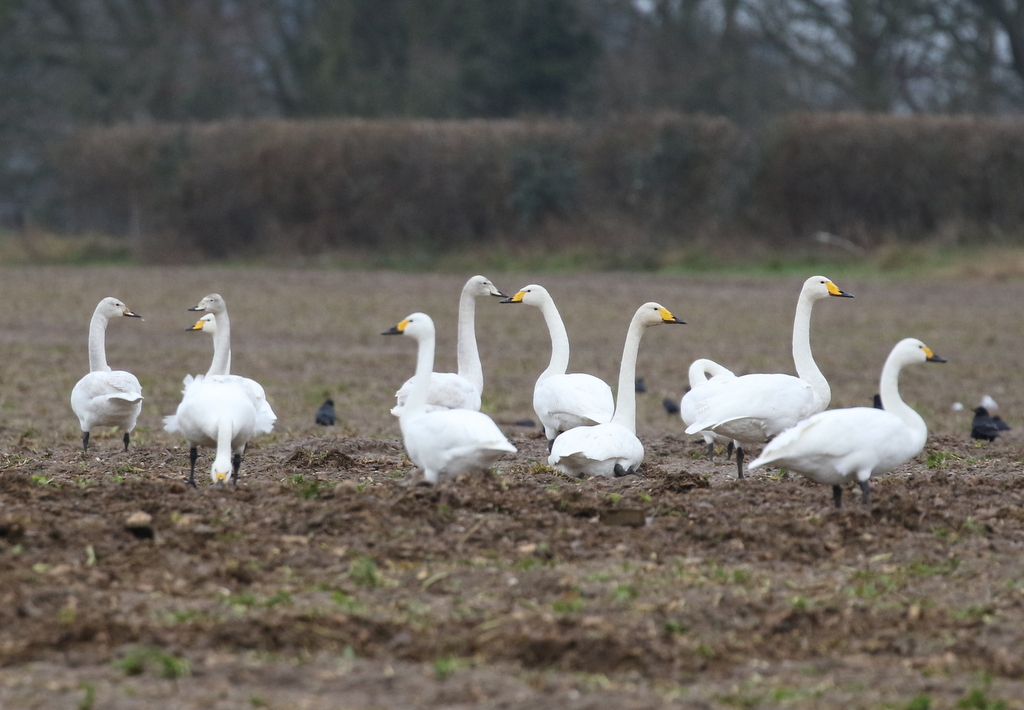
We managed to find somewhere to pull in off the road and had a closer look. There was a mixture of Bewick’s Swans and Whooper Swans, about thirty of each. It was nice to be able to see the two species side by side, in the same scope view. The Bewick’s Swans were noticeably smaller and shorter necked, with a smaller and more squared-off patch of yellow on the bill, compared to the long wedge of the Whooper Swans.

Having enjoyed such great views of the swans by the road, the pressure was off at Ludham now. Still, we drove down to the river to see if we could find any Cranes. A large flock of Woodpigeons and Stock Doves flew up from around the barns as we got out of the van.
It was very windy up on the river bank, and it started to spit with rain. A large flock of Lapwings and Golden Plover flew up across the other side of the Levels, but we couldn’t see what had spooked them. Three large shapes were flying across in the distance, which we could see were Common Cranes, our first of the day. They crossed the river and looked for a second like they might turn in our direction, but instead flew off away from us.
There were a handful of Mute Swans feeding on the grass here, but we could see a very large herd of swans way off beyond St Benet’s Abbey. They were mostly hidden behind a line of reeds, but we got the scope on them and they appeared to be mostly Bewick’s Swans. Since we had enjoyed such good views of them earlier, we decided not to walk further along the bank. We turned and headed back to the shelter of the van.
We did drive round to St Benet’s Abbey, to see what we could find there. As we came down along the entrance road, several more Bewick’s Swans flew over, but went down out of view.
There were lots of Greylag Geese on the grass here, but when we pulled up to check a flock by the side of the track, we could see there were Russian White-fronted Geese with them. We found somewhere to pull over and got out for a closer look. There were actually at least 55 White-fronted Geese here, many asleep down in the grass, but some feeding so we could see their distinctive black belly bars. There was one Barnacle Goose here too – as ever, it is hard to tell whether individuals of this species are feral birds or wandering wild individuals.

From St Benet’s, we had a quick drive round via the coast, to see if we could find any Cranes and any more flocks of geese. There was no sign of any Cranes today, but it was rather windy and exposed out here now. There were rather few geese visible too. We saw a couple of small flocks of Pink-footed Geese but they dropped out of view behind some tress. Six more Pink-footed Geese were in a winter wheat field by the road, but no sign of any large flocks today. The herd of swans here were all Mute Swans.
As we made our way inland, we finally managed to spot some Cranes on the ground. There were 12 of them together, standing in some winter wheat, but they were rather distant, several fields over. Still, we got them in the scope and had a better look at them.
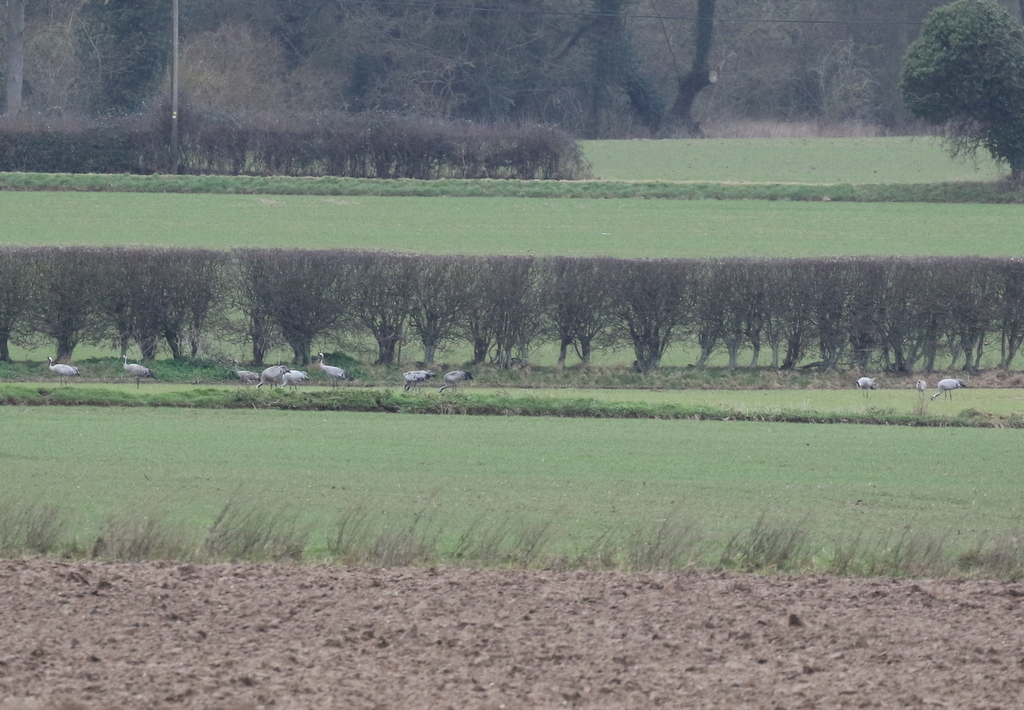
Three of the Cranes took off and flew back further away from us, before landing again in another field. Gradually, the others followed in small groups until only two were left. When they flew too, we watched them go and realised that the group had all landed closer to a small road some way off. We figured we might be able to drive round for a closer look.
Little did we realise how right we were. The Cranes had landed in another field right next to the minor road. Edging along slowly, and stopping regularly to allow them to get comfortable with our presence, we eventually found ourselves right alongside them. The birds were very relaxed as we watched them from the van, continuing to feed. We could see now there were ten adults and two browner juveniles. We could see the red on the crowns of some of the adults, even without a scope. Stunning views, a real treat and a privilege to see them like this.
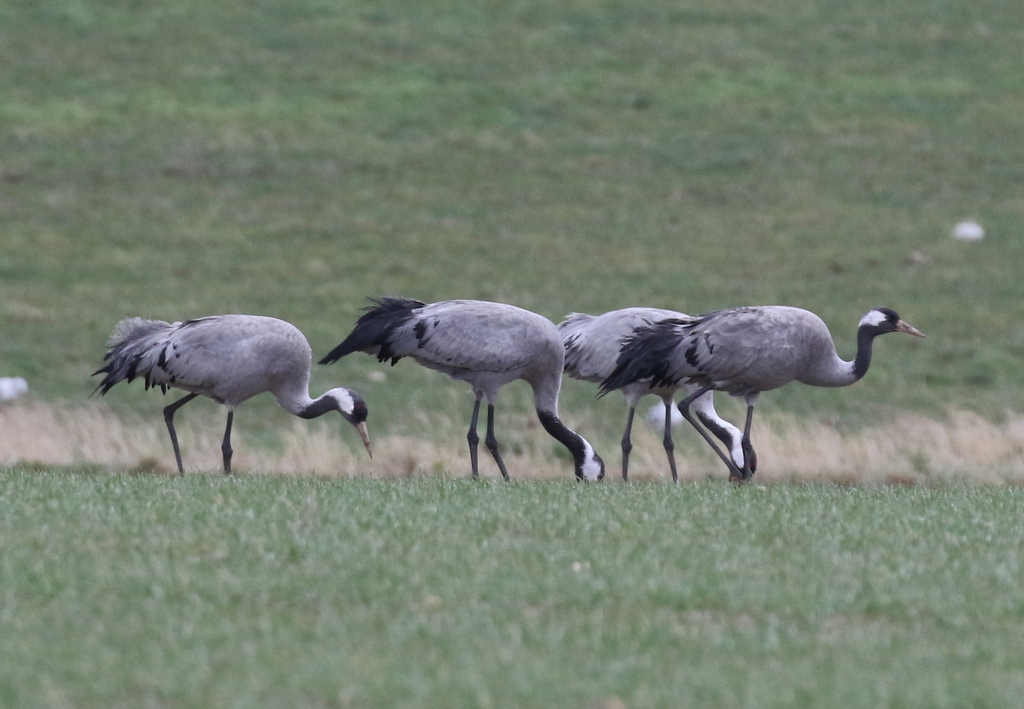
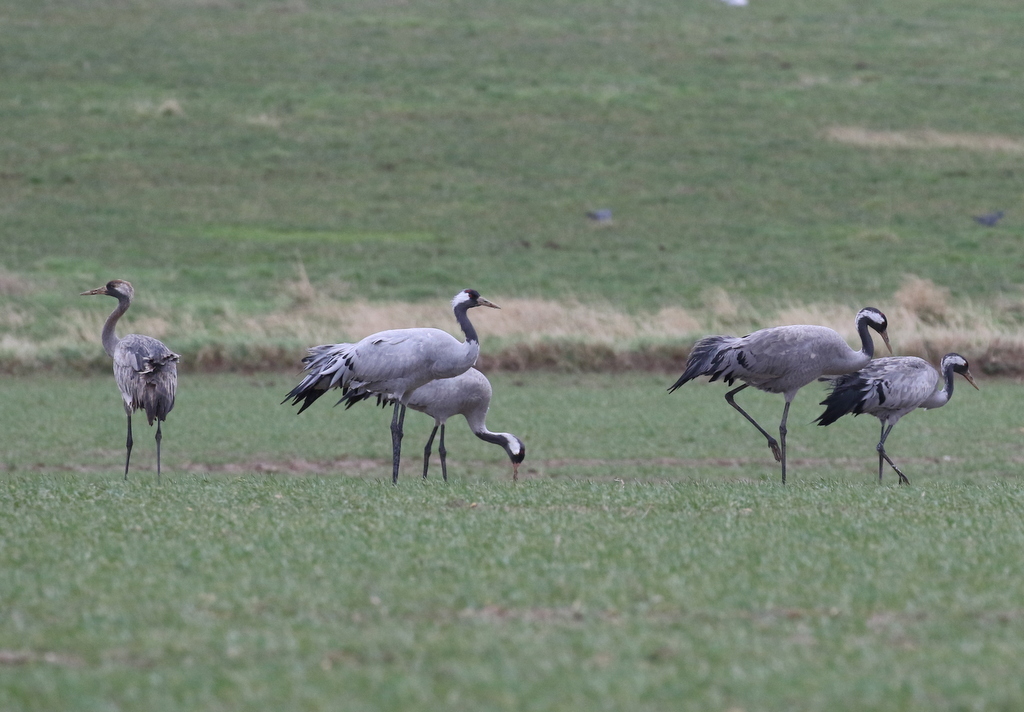
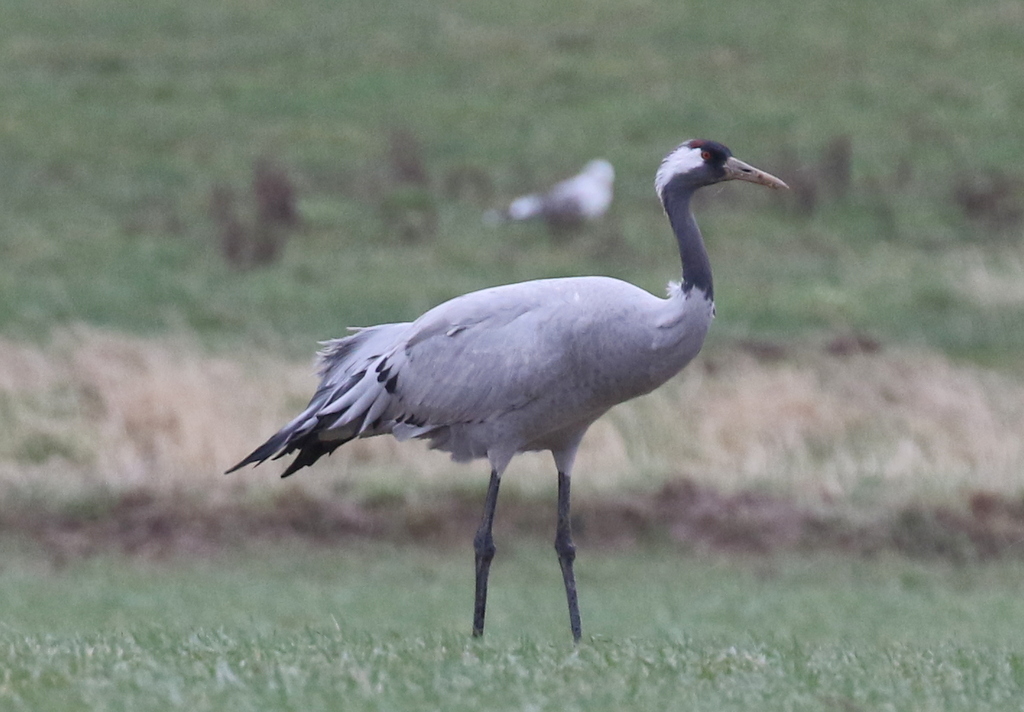
We watched the Cranes, spellbound, for a while. Then we decided to leave them in peace and drove slowly away.
It was time for lunch now, so we headed round to the RSPB reserve at Strumpshaw Fen. Huge thanks have to go to the warden, Ben, and his staff. Someone had called in sick and they didn’t have enough people to staff the reception, so they had just closed it up for the afternoon. But they very kindly switched on the hot water urn just for us, so we could get an extremely welcome hot drink.
There were a few ducks on the Reception Hide pool, Gadwall, Shoveler and Mallard, but there was no sign of the resident Black Swan today. It was probably hiding somewhere out of the wind, which had increased steadily through the morning. There were plenty of Coot too and when they all suddenly raced across the water and onto the cut reeds at the front, we thought something might have spooked them, but we couldn’t see what it was.
Possibly also due to the wind, there were fewer tits than normal coming down to the feeders today too. A steady stream of Great Tits came in and out, but no sign of any Marsh Tits today.
After lunch, we headed round to Buckenham. As we crossed the railway line, we could see some geese on the right of the path. Looking closer, we found there were seven Russian White-fronted Geese in with the Greylags. There were lots of Pink-footed Geese on the other side of the path, tucked up in the far corner by the railway. Several small groups flew round and landed much closer to the path where we could finally get a good look at them.
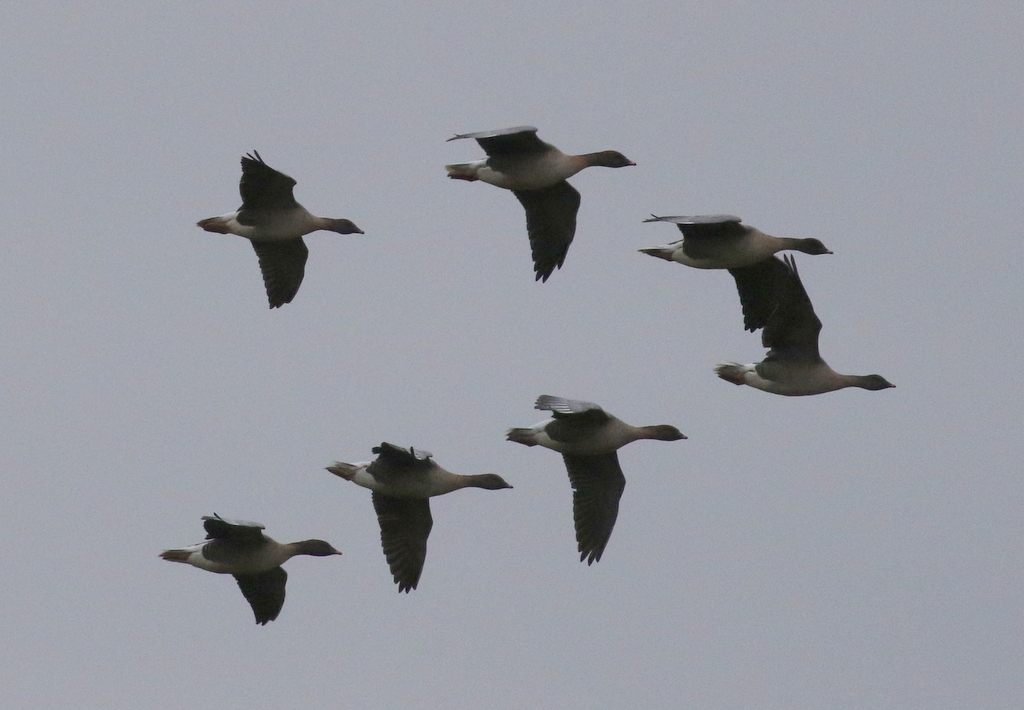
The Wigeon were rather nervous today, possibly due to the wind. There are normally several small groups right by the path, but they were all out in the middle. There were plenty of Lapwing out on the marshes too, and scanning through them carefully we found a couple of Ruff in with them. We could see several Chinese Water Deer out on the marshes as well.
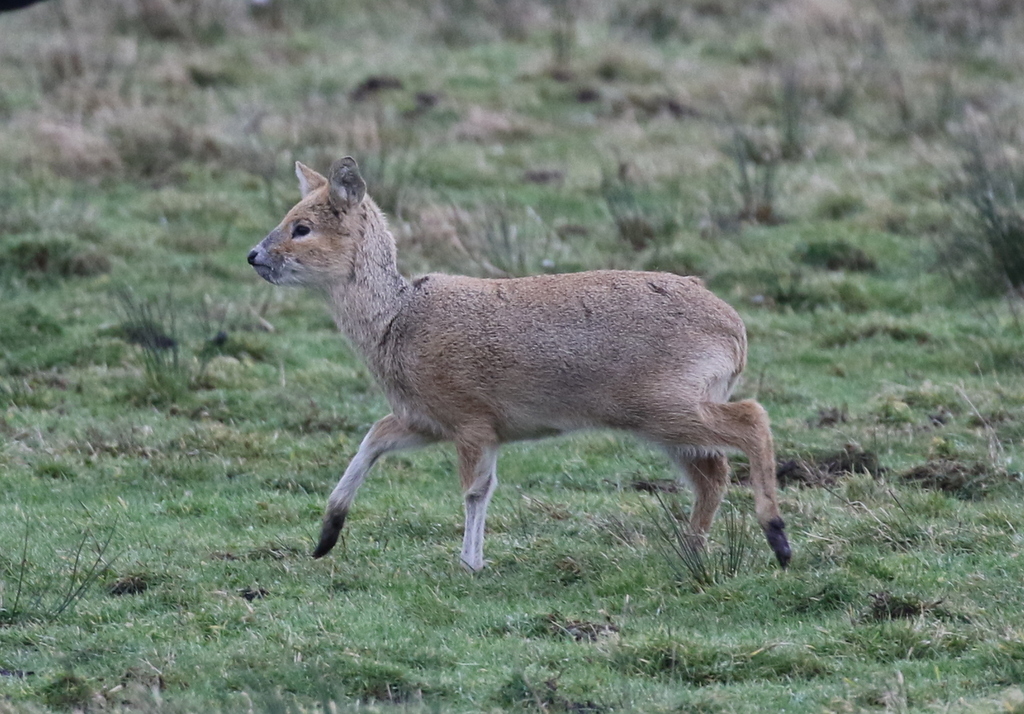
It was rather exposed out here in the wind, so we made our way up to the hide by the river bank. We could see lots of ducks on here, mainly Teal, but also a few Shoveler and a couple of Shelduck. Something spooked all the Wigeon from the grazing marshes the other side of the track and they flew in, calling noisily. A quick count suggested at least 1,000 were here.
A single Lesser Black-backed Gull was loafing on the water on the further pool. We couldn’t see any other waders out here today though, and despite scanning the margins of the pools very carefully we couldn’t find any Snipe.

It was grey and windy but miraculously still dry this afternoon. We wanted to have a look at the watchpoint at Stubb Mill while the weather held, so we headed round there next. As we walked down the track from the car park, several Marsh Harriers were already circling over the reeds.
We noticed another bird come up from the reeds. It seemed to struggle in the wind at first, almost appearing to be hovering, before it turned and started to fly across over the reedbed. It was a Bittern! Unfortunately, it was hard to see in the gloom, low over the reeds, before it disappeared behind some bushes.
When we arrived at the watchpoint, the small huddle of hardy people already there pointed out three Cranes at the back of the marsh. We had a look at them through the scope – another family party, two adults and a juvenile.
A small flock of Fieldfares flew over and landed first out on the grass in front of the watchpoint, then in one of the small hawthorns. A group of Long-tailed Tits worked their way through the bushes in front of us too. A Red Deer appeared out on the grass, followed shortly after by a second. They spent most of the time sheltering behind a large patch of brambles, out of the wind.
More Marsh Harriers drifted in and we could see a few already in the bushes over by the old ruined mill. When they flew up and circled round in a group, we counted at least 25 in the air together. A Hen Harrier appeared with them, a ringtail. It kept low, flying in and out of the bushes, but it reappeared several times while we were there, so in the end everyone had a chance to get a look at it through the scope.
Having had some unbeatable views of the Cranes earlier, and with the rather cold and windy weather, we didn’t fancy staying until dark tonight to see more Cranes come in to roost. An advance party went to get the van, while the others waited a the Watchpoint to be picked up. A Tawny Owl hooted from the trees by the mill. Time to head for home.
















